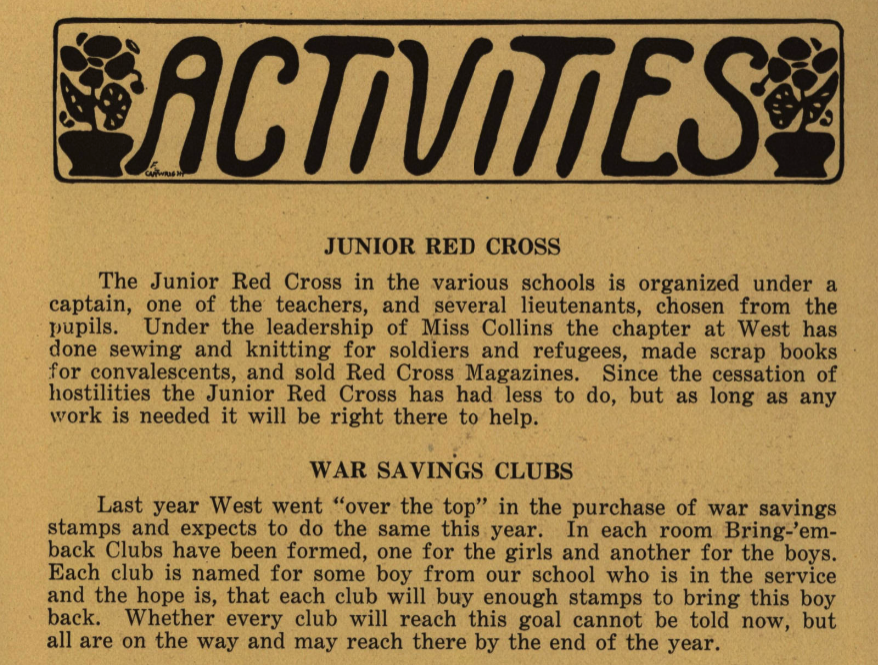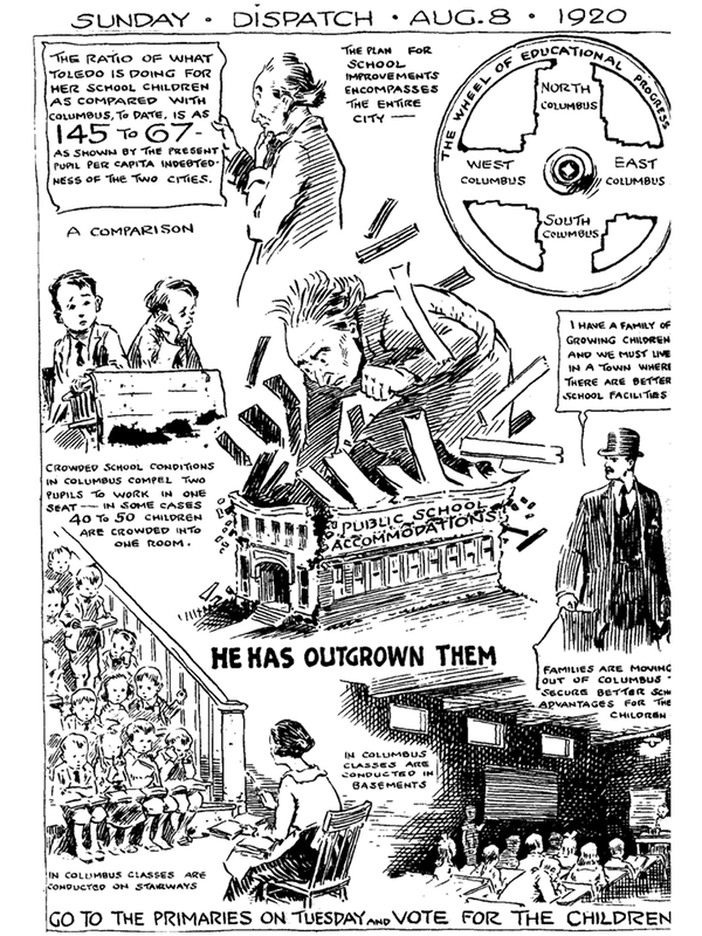|
PART 2. HISTORICAL CONTEXT: INFLUENZA, WAR, AND PROGRESSIVE COLUMBUS by Matt Doran Columbus Schools and the War Effort Setting the 1918 influenza pandemic into the historical context of World War I and the Progressive Era sheds additional light on this event. The second wave of influenza in the fall of 1918 began during what turned out to be the final months of World War I. It was a period of heightened patriotism and sacrifice. The inconvenience of closures and cancellations surely paled in comparison to the greater sacrifices made for the public good, and indeed the threats to Americans’ civil liberties. To join the 2 million volunteers, the U.S. drafted 2.8 million men into military service[20], and prosecuted more than 2,000 dissenters for opposing the war or the draft.[21] The Espionage Act of 1917 made it a crime to interfere with the war effort or disrupt military recruitment. The Sedition Act of 1918 criminalized expression deemed disloyal. Many Columbus Schools alumni joined the fighting in World War I. Eddie Rickenbacker, who had attended East Main Street School, became America’s “Aces of Aces,” shooting down 26 German planes during the war. Chic Harley, a 1915 graduate of East High School, had already made a name for himself as a college football star at Ohio State when he became an army pilot in 1918. Harley came home from the war and played another season at Ohio State. But at least thirteen of his East High School schoolmates were among the fatalities of World War I.[22] South High School sent over 160 alumni to war and reported a loss of five soldiers, including one who died of influenza at Camp Sherman near Chillicothe. Over 100 West High School alumni joined the war effort as well, with just one loss of life.[23] On the home front, Americans supported the war effort by planting victory gardens and buying liberty bonds. Students also contributed to the war effort, including 9,000 children who joined the war garden army in Columbus.[24]
South High School’s "History of the Class of 1919" declared, “To prove our patriotism, instead of giving an elaborate party...money was used to purchase a Liberty Bond, to be left to the school as a parting gift.”[28] Because of its large German-American population, the need to demonstrate patriotism would have been especially acute for residents of the Southside. During the war, German books were burned at Broad and High Streets. German schools and the last German newspaper were closed and never reopened. Within a few blocks of South High School (then located on E. Deshler Avenue), Schiller Park was renamed Washington Park, Schiller Street was renamed Whittier, and Germania became Stewart Avenue. Columbus Schools in the Progressive Era The 1918 influenza pandemic came near the end of the Progressive Era, a period of social, political, and economic reforms. Expanding education was a primary goal of Progressivism. In 1910, only 48 percent of all students entering high school stayed beyond their first year, and only 7 percent graduated. [29]
School lunch programs were present in at least some Columbus schools by 1918. In partnership with the Home and School Association, Columbus was one of the first cities to have an elementary school lunch program.[31] The first Penny Lunch program began in 1912 at Mound Street School. There was, however, no federally subsidized school lunch program in the United States until 1946. There are no records of school lunches being served during the influenza closures. The task of feeding the children almost certainly fell to families and local charities. Many families were already feeling the strain of the war. With men off to the army, women began assuming work outside the home on assembly lines producing trucks and munitions. The U.S. Food Administration under Herbert Hoover managed food distribution and prices, and led a campaign to teach Americans to economize their food budgets and grow victory gardens. Settlement houses were part of Progressive Era social reforms. Typically staffed by middle class women, these organizations were often located in immigrant neighborhoods of industrial cities. They provided education, healthcare, childcare, and social programs for children. Families in need may have turned to one of four settlement houses in Columbus in 1918: Godman Guild (1898), Southside Settlement House (1899), Gladden Community House (1905), and St. Paul’s Neighborhood House (1909). Founded by North High School English teacher Anna Keagle, the Godman Guild on W. Goodale Street served the Flytown neighborhood. As part of the war effort, the Godman Guild managed community gardens for 350 families in the spring of 1918.[32] The harvest surely helped families during the fall influenza pandemic. From 1908-1930s, free milk was distributed to families at the Godman Guild. With the end of World War I and the influenza pandemic, the United States experienced a postwar boom leading into the “Roaring Twenties.” Between 1910 and 1920, the population of Columbus increased from 181,511 to 237,031. By 1930, there were 290,564 Columbus residents.[33] To alleviate overcrowding in schools, Columbus built four new buildings for its high schools in the 1920s: East (1923), Central (1924) North (1924), South (1924), and West (1929). Three of the old high school buildings became jr. high schools. ENDNOTES [20] “Historical Timeline.” Selective Service System, n.d. https://www.sss.gov/history-and-records/timeline/
[21] Trickey, Erick. “When America's Most Prominent Socialist Was Jailed for Speaking Out Against World War I.” Smithsonian Magazine, June 15, 2018. https://www.smithsonianmag.com/history/fiery-socialist-challenged-nations-role-wwi-180969386/ [22] East High School, The Crucible, (Columbus, OH: 1921), 5, Columbus Metropolitan Library, https://digital-collections.columbuslibrary.org/digital/collection/yearbook/id/27704/rec/20 [23] The Occident, 1919, 8. https://digital-collections.columbuslibrary.org/digital/collection/yearbook/id/28412 [24] Hooper, 1920. 85. [25] The Occident, 1919, 4. https://digital-collections.columbuslibrary.org/digital/collection/yearbook/id/28396/rec/1 [26] East High School, The Crucible, (Columbus, OH: 1918), 81, Columbus Metropolitan Library, https://digital-collections.columbuslibrary.org/digital/collection/yearbook/id/27683/rec/11 [27] Ibid. 83 [28] South High School, The Annual, (Columbus, OH, 1919), 28, Columbus Metropolitan Library, https://digital-collections.columbuslibrary.org/digital/collection/yearbook/id/4374 [29] “Notable Milestones in the History of Columbus Public Schools.” Columbus City Schools, https://www.ccsoh.us/cms/lib/OH01913306/Centricity/Domain/158/CCS%20Through%20the%20Years.pdf [30] “School Development in the Last 27 Years.” Columbus School News, June 9, 1916. 5, https://digital-collections.columbuslibrary.org/digital/collection/yearbook/id/8957/rec/34 [31] Ibid, 8. https://digital-collections.columbuslibrary.org/digital/collection/yearbook/id/8962/rec/34 [32] Hooper, 1920. 85. [33] “Columbus Population,” World Population Review. https://worldpopulationreview.com/us-cities/columbus-population/
1 Comment
Jenny Perks
5/8/2020 09:02:51 pm
Matt,
Reply
Your comment will be posted after it is approved.
Leave a Reply. |
Archives
May 2020
Categories
All
|





 RSS Feed
RSS Feed
